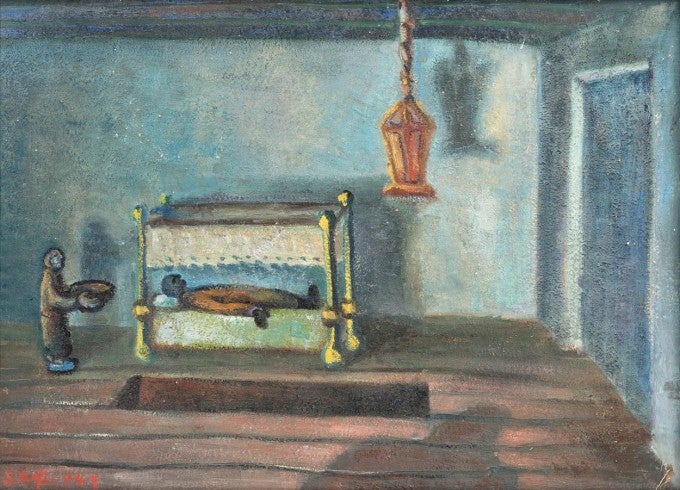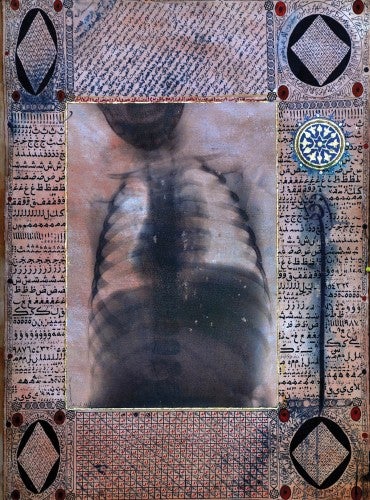
From cholera, to plague, to COVID-19, contagious diseases have shaped human history in profound ways and offered MENA historians unique lenses into the past.
By Dr. Benan Grams
Just as the world was starting to recover from its battle with the still new and relatively unknown Covid-19 SARS virus, an old horrific disease has returned to the Arab world earlier this year, threatening to unleash another human disaster. In late August, cholera broke out in Syria’s northeastern region around the Euphrates. It quickly spread to other parts of the country, and by early October had become a regional epidemic, with cholera outbreaks reported in neighboring Lebanon. Cholera now threatens to reach other areas in the Middle East and beyond, accelerating it from an epidemic impacting a limited geographic area to a global pandemic hitting multiple regions around the world
While cholera was the nineteenth century’s most dreaded disease, it was neither the first nor the only pandemic to impact societies around the world. Deadly diseases like plague and smallpox had terrorized the Middle East, Asia, Europe, and other parts of the world for centuries. Plague epidemics (طاعون), which recurred in the Levant, Mesopotamia, Anatolia and Egypt until the first half of the nineteenth century, were addressed by the prophet Mohammad and became a subject of debate in Islamic tradition. While plague targeted various segments of society, smallpox was a disease that killed primarily children. Those who survived it were left with scars but also immunity for life. Other documented infectious diseases like measles, tuberculosis, malaria, syphilis, typhoid, and typhus also killed hundreds of thousands of people, weakened armies, caused displacement, and caused economic devastation by leaving ripe agricultural crops unharvested.
Epidemics—defined as high-impact infectious diseases—differ from chronic, non-infectious diseases (such as heart disease and cancer) primarily by their sudden appearance and the relative brevity of their duration. Epidemics are also distinctive for the magnitude of their damage, and the scale of their impact. Causing rampant collective illnesses, epidemics result in sweeping calamities and anxieties comparable to those caused by wars, revolutions, and economic crises. Just as we have seen recently with COVID-19, epidemics affecting past societies influenced economic and political decisions and left their traces on cultural norms and habits, as well as on religious beliefs and practices.

In the past century, scholars acknowledging the multifaceted impacts of epidemics have examined the effects of plague on the MENA region’s historical trajectory. Their interest in the history of plague in the Middle East specifically reflected western fascination with plague within European history and orientalists’ preoccupation with medieval Islamic medicine. The first to systematically examine plague history was Michael Dols in his book The Black Death (published in 1977). He was followed by Lawrence Conrad, whose work focused on the Justinianic Plague, and Joseph van Ess, who studied seventh-century plague in Syria, among several others. Their work focused on plague in the pre-modern Islamic era and was primarily concerned with concepts of contagion, disease, and health in medieval Islamic medicine. Growing from the field of Islamic Studies, their scholarship on plague was also characterized by its strict reliance on textual analysis of early Islamic medical treatises, poems, and other Islamic texts. Scholars of this early literature on plague were forerunners in curating interest in Middle Eastern medicinal and disease history. Their work is considered foundational in the historiography of Islamic medicine, and their methodology of rigorous textual analysis continues to inspire younger scholars interested in the history of Arab and Greek medicine.
In many respects, however, this early scholarship perpetuates “epidemiological orientalism,”— a term coined by Nükhet Varlık to describe the ways Europeans viewed, experienced, imagined, reproduced, and represented the Ottoman healthscape. Epidemiological orientalism can be discerned in the writings of 18th-century European doctors studying plague in Ottoman societies, European travelers, and diplomats to the region in the 19th century. Indeed, Western travelers to the Ottoman Empire, and those who took residence in its commercial centers, repeatedly contrasted Europeans’ behaviors with those of the locals during epidemics. According to their accounts, when plague broke out in a city, European consuls and merchants shut themselves up in their quarters, voluntarily restricted their movements, halted any interactions with others, and avoided touching any objects that had not been fumigated. Local Christians emulated European residents, also isolating themselves—thus, usually preserving their lives. In contrast, the accounts continue, Muslims went about their days as usual and without concern for the looming danger threatening their lives. They were “more intrepid,” according to these outside observers, as a result of their faith and doctrine of predestination. In a nutshell, the reaction by “Orientals” to infectious diseases was a matter of doctrinal guidance—one faith promoted life and the other death—thus producing the trope of Muslim fatalism.
Although epidemiological orientalism is a product of the geopolitical dynamics between the Ottoman Empire and western powers, Michael Dols and his generation of scholars did not question this portrayal of Ottoman and Islamic societies as fatalist or indifferent to epidemics. Nor did they challenge the framing of their responses to disease calamities in sectarian terms. Such questioning would come later from historians outside the field of Islamic studies.
Since the early 2000s, a new generation of scholars has been examining past epidemics and their impacts—doing so through the lenses of the larger political, economic and environmental contexts in which they occurred. For example, Sam White and Alan Mikhail have looked at the impact of climate change on disease, environment, and health in Ottoman societies, while the work of Miri Shefer-Mossensohn explores the way diseases in the Ottoman Empire were understood socially and culturally. Others, such as Hannah-Louise Clark, Seçil Yılmaz, and Hibba Abugideiri, have looked at the intersections of colonialism, imperialism medical knowledge, and gender. By redefining the space and periodization of their units of analysis, this new school of disease history illuminates the impact of epidemics on demographic volatility, political decisions, imperial and colonial expansions, modernization and economic development, popular reactions, and socio-cultural changes.
While plague continues to feature prominently in historical investigations, more and more historians are examining other infectious diseases like influenza, smallpox, leprosy, cattle plague, cholera, syphilis and tuberculosis. Recently, cholera has attracted the attention of historians studying the nineteenth-century Ottoman Empire due to the disease’s multifaced impact on the Empire and Post-Ottoman states. Their work shows how the disease influenced not only the development of public health sectors in the Ottoman Empire and newly established nation states following the first world war, but also relations between the Ottoman imperial center and its periphery, and the Empire’s geopolitical position, especially vis-a-vis Western powers. My work on the impact of cholera on the transformation of Ottoman Damascus from 1848 to1918 joins this growing body of literature on disease history.

The new scholarship on epidemics and diseases relies on an interdisciplinary approach and utilizes methods and tools from a wide range of disciplines, including genetics, science and technology, sociology, anthropology, biology, geography, archaeology, Islamic studies, and numerous sub-disciplines within the field of history, including social, cultural, economic, global, environmental, and political history. For example, through the use of DNA, molecular biologists have completed a sequencing of the bubonic plague bacterium from 14th-century remains found in London, thus settling the question about the real cause of the Black Death in the city and making a significant contribution to plague history. Samuel Dolbee, Isacar Bolaños, and others have used tools and theories from the discipline of geography to examine disease movement within contested spaces and frontier regions. A growing number of Middle East scholars are engaging with questions about environmental influences on the history of the region, including the role of geography and the effects of diseases, natural disasters, and climate change. They are paying attention not only to conventional historical actors—primarily men, elites, intellectuals, and political figures—but also to non-human agents that have catalyzed past events: topographical elements like mountains, swamps, rivers and seas; insects, such as mosquitoes; and pathogenic organisms like viruses, bacteria, and other parasites. The power of non-human agents was demonstrated recently by the drought and floods that devastated Africa and Pakistan respectively and compelled officials in the World Health Organization to add climate change effects to the list of factors contributing to cholera’s spread—a list that also includes war, displacement, and, in the case of Syria, poor sanitary infrastructure.
The recent methodological expansion within disease scholarship has been spurred, in part, by the availability of a wider range of primary sources. The Ottoman archives in Istanbul, which were digitized in the 1980s, offer researchers a massive body of previously untapped documents, including official correspondence, technical reports, maps, and photos. These archives provide different perspectives and offer new possible explanations to historical events. Likewise, the digitization of 19th-century Ottoman newspapers and professional magazines has also been essential in reducing reliance on European consular reports and bringing forth local voices and experiences. While these new sources help take the history of disease beyond the confinement of Middle Eastern studies and the strict reliance on textual analysis of medieval Islamic writings, the new school of scholarship situates the Middle East’s experience of disease within larger spatial parameters. Rather than looking at the Arab world in isolation, it considers neighboring regions, border lands, and areas that, despite being geographically remote, were strongly connected to the region commercially, religiously, and militarily. This trans-regional approach also contributes to recent efforts to reorient world history away from a west-centric viewpoint and to include other regions that have long been considered peripheral.
Epidemics have had profound impacts on societies over the centuries, challenging and shaping their cultural norms, practices, and beliefs. Moving along commercial routes through human points of contact and shaped by a host of environmental factors, diseases offer a crucial lens for understanding the history of global interconnectedness. Diseases—after all—know no borders or nationalities.
Dr. Benan Grams is a MAAS alum (’14) and the current ADF Fellow at CCAS. She earned her PhD from the Georgetown Department of History, conducting her dissertation research on the social impact of cholera in Ottoman Damascus.